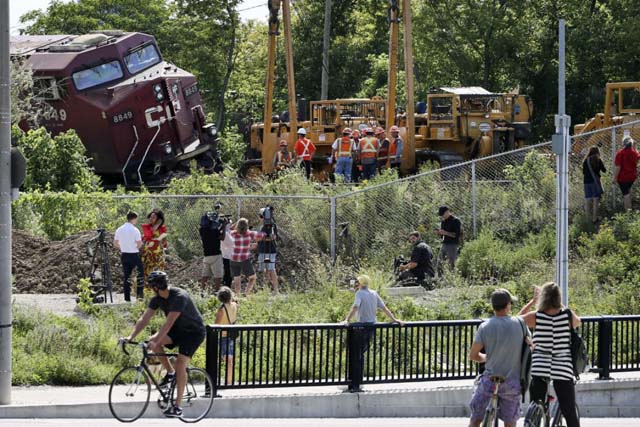
Should Serve as a Wake-Up Call
Toronto Ontario - The men guiding Canadian Pacific (CP) train 235 through pre-dawn Toronto found themselves scrambling to get to work with less
sleep than they had wanted.
On the night of 20 Aug 2016 the locomotive engineer had gone to bed at 22:15 requesting that he be woken at 05:30 so he could join a train scheduled to leave
the yard in Scarborough at 07:00.
Instead, he was called at 03:15 and ordered to work just 90 minutes later.
His co-worker, a conductor, had it even worse.
He was living in Smiths Falls, outside Ottawa, and was told to report to work in Toronto.
He slept in his car for a few nights.
On the evening of 20 Aug 2016 he dozed in his car for 90 minutes before reporting for duty just before midnight.
He hadn't had a solid night's sleep for days.
The two men headed west from Scarborough at 05:00.
Their train, which consisted of just two locomotives, passed through the quiet streets of Leaside and Rosedale to midtown Toronto.
Fourteen minutes later, while travelling at 77 km/h on the north track, it rounded a right-hand curve and passed by a signal warning of a stop signal just
ahead.
Seconds later, the crew saw an eastbound train, CP train 118, on the south track and didn't notice immediately that the tail end of this 3,000-foot-long train
was on a crossover linking the north and south tracks with its last cars still on the north track about half a mile away.
When the engineer on train 235 did notice what was going on, he hit the emergency brakes.
It was too late.
His train clipped four of train 118's cars before the two locomotives derailed and came to rest near Howland Avenue, just off Dupont Street, and spilling 2,500
litres of diesel fuel.
It was 800 feet past the signal ordering it to stop.
Annex residents jolted awake that morning had cause to wonder what had happened on their doorstep.
A recent report by the Transportation Safety Board (TSB) provides little comfort that this was an exceptional, once-in-a-lifetime incident.
Indeed, the board shows a sense of weariness that issues on its "watchlist" are not being dealt with.
It suggests that fatigue from unpredictable sleep patterns likely played a part in the accident and it notes that Transport Canada (TC) is not doing enough to
deal with train crews operating without adequate rest.
Additional physical fail-safe defences have not been implemented to ensure railway signals are recognized and followed.
(The TSB notes that technologies for ensuring that signals are following, some dating from the 1920, have been implemented in the United States but are not in
use in Canada.)
TC, which is in the midst of a review of the Railway Safety Act, needs to determine why Canada's railways have made only marginal progress on safety in the
past 30 years despite a succession of reports that said the system for shipping dangerous goods needs improvement.
The derailment on Howland Avenue should serve as a wake-up call.
The CP corridor through midtown Toronto is the route on which tens of thousands of tank cars carrying flammable liquids, such as ethanol and other dangerous
goods, are shipped.
Relocation of the midtown CP line to a less densely populated area was first recommended in a royal commission report that investigated the derailment and
explosion of a CP train in Mississauga in 1979.
But relocation, while it may assuage residents of midtown Toronto, is not an answer to the challenge of moving dangerous goods across Canada.
Shipment by rail will never be completely without risk but there are a number of measures the government could mandate that would reduce this
risk.
In the shorter term, for example, the phase-out of inadequate tank cars currently set for 2025 should be accelerated and better braking systems
mandated.
As well, trains carrying dangerous goods should be shorter and travel at lower speeds.
The authors of the TSB report are too cautious to call out successive governments for their inattention to rail safety but they make it clear that it remains a
critical issue that urgently needs to be addressed.
Kilgour Hervey and Henry Wiercinski - co-chairs of Rail Safety First.
of the Canadian Copyright Modernization Act.


